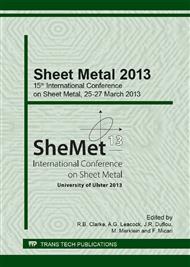p.284
p.295
p.302
p.311
p.317
p.325
p.333
p.340
p.349
Numerical Optimisation of a Shear Specimen Geometry According to ASTM
Abstract:
Complex material models used for the numerical representation of forming processes need in addition to tension and compression tests also shear tests to completely analyse the behaviour of the material under different loading conditions. There are two concepts of shear test one uses symmetrical specimens with two shear zones (according to Miyauchi) the other one specimens with a single shear zone. In both cases, a homogeneous distribution of the strain in the shear zone is essential for the validity of the shear test. Therefore, the length and width of the shear zone in a single shear specimen made from high strength steel according to the ASTM standard geometry were varied. Analysing the resulting strain distribution numerically an optimised sample geometry with a more uniform strain distribution than the ASTM standard was achieved. The numerical results were also validated with experimental shear tests.
Info:
Periodical:
Pages:
317-324
Citation:
Online since:
April 2013
Authors:
Price:
Сopyright:
© 2013 Trans Tech Publications Ltd. All Rights Reserved
Share:
Citation:


